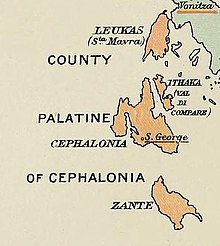Our website is made possible by displaying online advertisements to our visitors.
Please consider supporting us by disabling your ad blocker.
County Palatine of Cephalonia and Zakynthos
| County Palatine of Cephalonia and Zakynthos Παλατινή Κομητεία της Κεφαλονιάς και της Ζακύνθου (Greek) Palatiní Komiteía tis Kefaloniás kai tis Zakýnthou | |||||||||||
|---|---|---|---|---|---|---|---|---|---|---|---|
| Vassal state of various countries, de facto autonomous | |||||||||||
| 1185–1479 | |||||||||||
 County Palatine of Cephalonia and Zakynthos | |||||||||||
| Capital | Castle of Saint George | ||||||||||
| Government | |||||||||||
| • Type | County palatine | ||||||||||
| Count palatine | |||||||||||
• 1185–1195 | Margaritus of Brindisi | ||||||||||
• 1448–1479 | Leonardo III Tocco | ||||||||||
| Historical era | Middle Ages | ||||||||||
• Established | 1185 | ||||||||||
• Divided by the Ottoman Empire and the Republic of Venice | 1479 | ||||||||||
| |||||||||||
| Today part of | Greece | ||||||||||
The County Palatine of Cephalonia and Zakynthos existed from 1185 to 1479 as part of the Kingdom of Sicily. The title and the right to rule the Ionian islands of Cephalonia and Zakynthos was originally given to Margaritus of Brindisi for his services to William II, King of Sicily, in 1185.
Following Margaritus, the county passed on to a branch of the Orsini family until 1325, when it passed briefly to Angevins and then, from 1357, to the Tocco family. The Tocco used the county as a springboard for their acquisition of lands in the Greek mainland, and were successful in gaining control over the Despotate of Epirus in 1411. However, facing the advance of the Ottoman Turks they successively lost their mainland territories and were once again reduced to the County Palatine, which they held until 1479, when it was divided between Venice and the Ottomans. Zakynthos was put under the direct rule of Venice.
Previous Page Next Page
Графства Кефалініі і Закінфа BE Графство Кефалония и Закинтос Bulgarian Comtat Palatí de Cefalònia i Zacint Catalan Pfalzgrafschaft Kefalonia und Zakynthos German Παλατινή Κομητεία της Κεφαλονιάς και της Ζακύνθου Greek Condado Palatino de Cefalonia y Zacinto Spanish Comté palatin de Céphalonie et Zante French Condado palatino de Cefalonia e Zante GL Contea palatina di Cefalonia e Zante Italian Hrabstwo Kefalenii Polish


